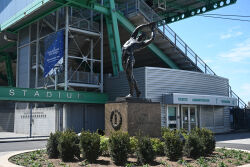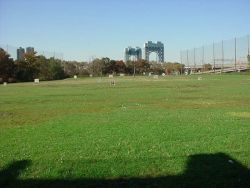Randall's Island Park
Randall’s Island
Dutch Governor Wouter Van Twiller purchased Randall's Island, then known as Minnahanonck, from Native Americans in 1637. Over the next 200 years, Randall's Island was used for farming, as a station for British soldiers, and as a quarantine area for smallpox victims. The island was purchased by Jonathan Randel (or Randal) in 1784, for whom it is named (although with a different spelling). His heirs sold it to the city for $60,000 in 1835.
Randall's Island is located along the East River between Northern Manhattan and Queens. After its purchase, the city built a burial ground for the poor, a poorhouse, a House of Refuge for juvenile delinquents, an Idiot Asylum, a homeopathic hospital, an Inebriate Asylum, and a rest home for Civil War veterans on the island. The physical isolation of the island provided distance between the public and the institutions for the sick and the poor. In 1930 the Metropolitan Conference on Parks recommended that the island be cleared of its institutions and be used solely for recreation. In 1933 the state acted on the Conference's recommendation by transferring ownership to Parks & Recreation. This began the island's transformation into a recreational hub.
Access to Randall's Island was made much easier with the opening the Triborough Bridge by President Franklin D. Roosevelt in 1936. Parks Commissioner Robert Moses launched a comprehensive program to build recreational spaces such as ballfields, playgrounds, and a stadium (named Downing Stadium in 1955 for former Director of Recreation John J. Downing). Moses evacuated the original children's hospital and closed the House of Refuge. Over the following three decades, Commissioner Moses gradually filled in the space between Randall's and Wards Islands to allow for even greater recreational area.
For many years, Downing Stadium was the centerpiece of activity on the island. It held a number of unforgettable sporting events beginning with Jesse Owens' victory in the 100-yard dash at the 1936 Olympic Trials with President Franklin Roosevelt in attendance. The stadium was named in memory. Soccer star Pele made his American debut for the New York Cosmos at Downing in 1975, and Tiger Woods hosted a golf clinic for city kids there in 1996. Downing Stadium held large music festivals -- the Duke Ellington Orchestra performed a memorial concert of composer George Gershwin in 1938. Jimi Hendrix, Steppenwolf, and Grand Funk Railroad played at the three-day New York Pop Festival of 1970.
In 1992, the Randall's Island Sports Foundation was formed to support capital projects and programming on Randall's Island. Downing Stadium was demolished in 2002 to make way for Icahn Stadium, a $42 million facility that opened in April 2005. The sole International Amateur Athletic Federation (IAAF) Class 1-certified, championship-quality track-and-field facility in North America, the stadium was financed with $18 million in private donations, including a generous gift of $10 million from Randall's Island Sports Foundation (RISF) trustees and donors Carl and Gail Icahn, who made the largest gift ever from a private donor to a New York City park facility. At the opening of Icahn Stadium, 2004 Olympic Gold medalist Justin Gatlin recreated Jesse Owens victory in front of Jesse Owens' daughter, Marlene Owens Rankin, who was in attendance.
The symbol of Randall's Island is The Discus Thrower statue (1926) which stood on the Downing Stadium plaza from 1936 until the 1970s. The bronze by Greek sculptor Kostas Dimitriadis, donated to the City of New York by Ery W. Kehaya, was returned to Randall's Island in July 1999. The statue was restored with major funding from RISF Board Member Michael Bloomberg and friends of RISF.
Check out your park's Vital Signs
Clean & Safe
Green & Resilient
Empowered & Engaged Users
Share your feedback or learn more about how this park is part of a
Vital Park System










